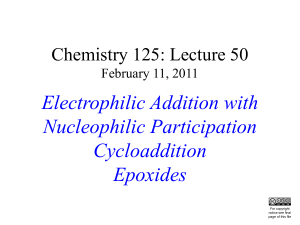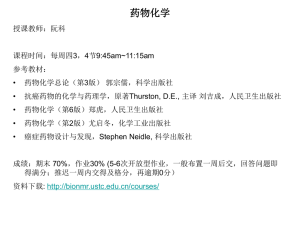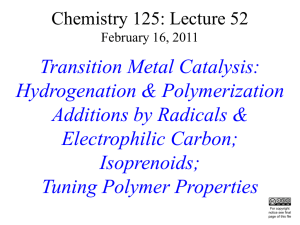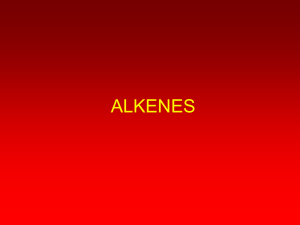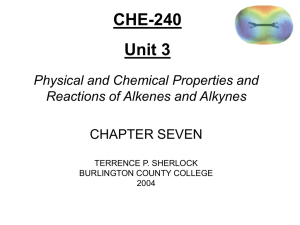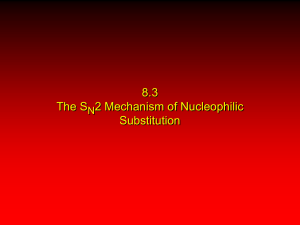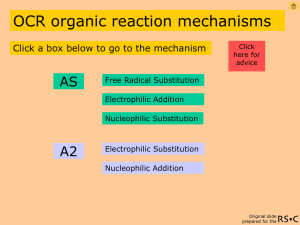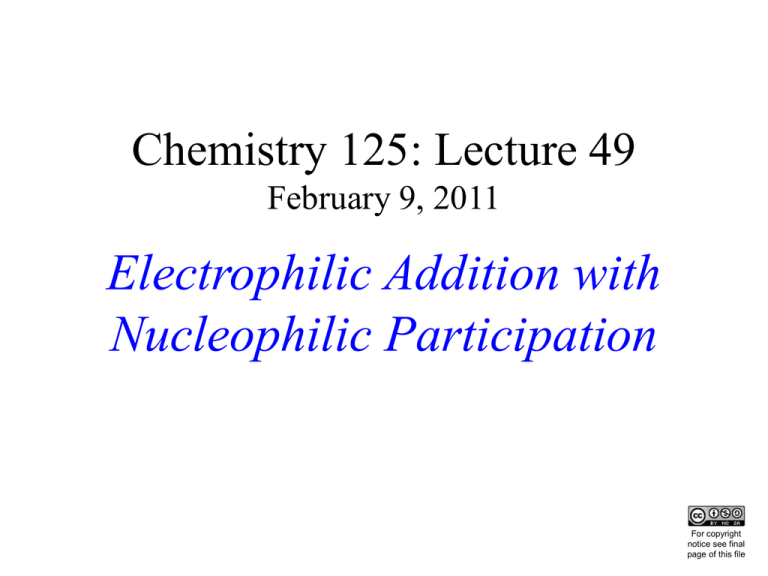
Chemistry 125: Lecture 49
February 9, 2011
Electrophilic Addition with
Nucleophilic Participation
This
For copyright
notice see final
page of this file
Problem:
Suggest a Multi-Step Mechanism for the
Acid-Catalyzed “Pinacol Rearrangement”
(draw nice curved arrows)
OH CH3
CH3
C
C
CH3
CH3
H+
CH3 C
CH3
C
+ H2O
O
CH3 OH
CH3
“Pinacol”
“Pinacolone”
The name was coined in 1859
from “pinax”, Greek for “tablet”,
because of the shape of
crystals of its hydrate.
+
CH3
CH3 C
CH
CH2
CH3
H+
H Catalyzed Hydration is
Subject to Rearrangement
An Alternative:
Oxymercuration
CH3
CH3 C
2° Cation CH3
+
CH
CH3
+
CH3
CH C CH CH
Reduction
3
CH3
3
3° Cation
(more stable)
H2O -H+
HO
CH3 C
CH3
CH3
CH
CH3
CH3
CH3 C
CH
CH2
An Alternative:
CH3
1) Hg(OAc)2 H2O
Reduction
2) NaBH4
Avoids Rearrangement
when Adding HOH
CH3 OH
CH3 C
CH3
Oxymercuration
CH
CH3
HO
CH3 C
CH3
CH3
CH
CH3
Hg(OAc)2
H2C
CHR
H 2O
HgOAc
+
H2C
CHR
Larger than H+, Hg+2 can overlap with both carbons
to give a single minimum and inhibit rearrangement.
+
HgOAc
H2C
HgOAc
HgOAc
+
+
CHR
H2C CHR
H2C CHR
O
H
H But the bridge is unsymmetrical, with weaker
bonding to the more substituted carbon.
-H+
H
HgOAc
H2C
CHR
OH
NaBH4
H2C
Subsequent reduction
by BH4- completes
CHR Markovnikov hydration
without rearrangement.
OH
Section 10.2b (414-421)
Addition of Cl2, Br2
(more unsymmetrical bridging)
Chlorine
electrophile
LUMO (*)
antibonding
HOMO (p)
(where the Cl-Cl
electrons went)
-
Cl2 is an
“oxidizing agent”
removes efrom alkene
poor
overlap
bonding
+
Two Cl-C
Bonds?
HOMO ()
Ethylene
HOMO-2
(where the electrons went)
Where are
HOMO &
HOMO-1?
Chlorine
nucleophile
HOMO (*)
-
:
+
LUMO (*)
Ethylene
Where are
HOMO-1 ! HOMO &
HOMO-1?
-
+
HOMO
(unshared pair on Cl)
HOMO-1
LUMO
-
ClCl
Cl
Cl+
:Cl
H2C
CH2
H2C
H2C
CH2
CH2
Cl
+
“Electrophilic” Addition
of Cl2 to an alkene
is both electrophilic
and nucleophilic
simultaneously.
LUMO
-
Halohydrins
ClCl
Cl
Cl+
:Cl
H2C
CH2
H2C
H2C
CH2
O-H
H
+
H O
CH2
+
O-H
H
H
J&F Section 10.2b (417-420)
Bromonium Regiochemistry
How do we know the ion is bridged?
Br-
Br+
H 3C
t-Bu
C
C
H
H
SN2
Br2
H 2O
H3C
t-Bu
C
C H
H
Br
t-Bu CH3
C
Br
C H
H
24%
Unsymmetrical Bridged
+
-H
Bromonium Ion
Br
t-Bu CH3
C
HO
J&F p. 420
C H
H
60%
“Halohydrin”
shows
Markovnikov
Regiochemistry
(like oxymercuration)
Section 7.9C (308-311)
Stereochemistry
49:48-54:24
Bromonium Stereochemistry
Anti Addition
Br2
H
H
-H+
Br+
H
Br
HO
H
H2O
H
H2O attacks
*C-Br from
backside.
H
trans
bromohydrin
(Unbridged C+ would have been attacked from both sides.)
J&F p. 419
Other “Simultaneous” Reagents
Cl2C: (Carbene)
R2BH (Hydroboration)
CH2I2 Zn/Cu (Carbenoid)
O
RC
(Epoxidation)
OOH
O3 (Ozonolysis)
H-metal (Catalytic Hydrogenation)
R-metal (Metathesis, Polymerization)
Carbenes
Reaction of CHnCl4-n with HObase
Jack Hine,
Reaction
of CHPh.D.
Cl (1950)
with PhSn
4-n
nucleophile
CH3Cl CH2Cl2 CHCl3 CCl4
fast
slow
fast v.slow
fast
slow
v. slow
K+
X for a postdoctoral”
“about as earthy a research project as could be appropriate
X3C H
O-C(CH3)3
X3C
X2C:
( X = Cl,Br )
-Elimination
J&F Section 10.4d (431-2)
But both HOMO/LUMO
& LUMO/HOMO pairs
are orthogonal!
H
+
Cl
Cl
C
LUMO
•
•
H
C
+
HOMO
C
H
H
Most reactions in this lecture use analogous LUMOs and
HOMOs to mix with the HOMO and * LUMO of H2C=CH2,
respectively, so as to form two bonds simultaneously.
Transition State Motion for F2C: + H2C=CH2
rotating
••
shrinking
stretching
shrinking
Transition State
F2C: + H2C=CH2
HOMO
F2C:
LUMO
HOMO
LUMO
H2C=CH2
How do we know both
bonds form at once?
CBr2
H 3C
C
C
H
CH3
H
if this intermediate
lasts >10-10 sec
CBr2
H 3C
C C CH
3
H
H
cis
But cis gives only cis
Br2
C
H 3C C
H
C CH
3
H
cis
rotate about single bond
Timing by
competition
with another
process
Br2
C
CBr2
H
H 3C
C
C CH
3
H
less strained
H C
H3C
C CH
3
H
trans
Hydroboration / Oxidation
Adds H OH
H
CH3
H
H BR2
CH3
H
BR2
H
HOOH
OH-
CH3
H
OH
J&F Sections 9.10-9.11 (390-401)
Transition State Motion for BH3 + H2C=CHCH3
stretching
rotating
shrinking
stretching
shrinking
Transition State
BH3 + propene
(distorted)
BH3
HOMO
LUMO
LUMO
HOMO
+3
(distorted)
C3H6
Rearrangement
after
Oxidation of BR3
HO
O
R2 B
CH3
Subsequent CH3BH2-O-OH rearrangement is like SN2
Cl-
*C-Br
HO
O
*O-O
R2 B
B-C
CH3
Subsequent CH3BH2-O-OH rearrangement is like SN2
Subsequent CH3BH2-O-OH rearrangement is like SN2
Transition State
LUMOs
HOMOs
very similar
Why do Hydroboration/Oxidation
if it just adds H and OH to C=C?
H
CH3
H BR2
H
CH3
H
OH-
H
regiochemistry?
stereochemistry?
BR2
CH3
HOOH
location
of OH?
H
OH
replaces BR2
Alcohol Product is syn (H,OH from same face of C=C)
and “anti-Markovnikov” (less substituted at C-OH)!
OH
CH3
Contrast with acid-catalyzed hydration
H
H Random
End of Lecture 49
February 9, 2011
Copyright © J. M. McBride 2011. Some rights reserved. Except for cited third-party materials, and those used by visiting
speakers, all content is licensed under a Creative Commons License (Attribution-NonCommercial-ShareAlike 3.0).
Use of this content constitutes your acceptance of the noted license and the terms and conditions of use.
Materials from Wikimedia Commons are denoted by the symbol
.
Third party materials may be subject to additional intellectual property notices, information, or restrictions.
The following attribution may be used when reusing material that is not identified as third-party content:
J. M. McBride, Chem 125. License: Creative Commons BY-NC-SA 3.0

